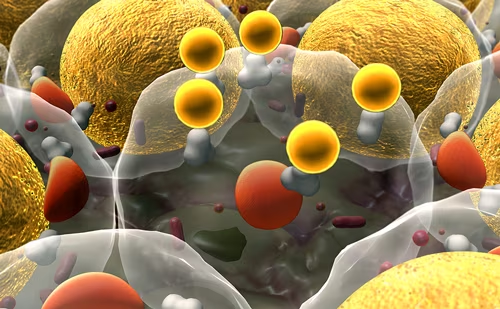Epidemiology
Recent statistics from the World Health Organization (WHO) indicate that in 2005 approximately 1.6 billion adults (aged 15 years and over) were overweight worldwide, while at least 400 million adults were obese. Furthermore, the WHO predicts that by 2015 approximately 2.3 billion adults will be overweight and more than 700 million will be obese.1 At the same time, diabetes currently affects 246 million people worldwide.
Epidemiology
Recent statistics from the World Health Organization (WHO) indicate that in 2005 approximately 1.6 billion adults (aged 15 years and over) were overweight worldwide, while at least 400 million adults were obese. Furthermore, the WHO predicts that by 2015 approximately 2.3 billion adults will be overweight and more than 700 million will be obese.1 At the same time, diabetes currently affects 246 million people worldwide. It is expected to affect 380 million by 2025, with the largest increases in diabetes prevalence in developing countries; most of the cases will be type 2 diabetes.2,3
Excess weight is the most important modifiable risk factor for the development of type 2 diabetes because 85–90% of people with type 2 diabetes are either overweight or obese.4 The term ‘diabesity’ has been coined to express that type 2 diabetes is obesity-dependent and that obesity is the main aetiological cause of type 2 diabetes.5 Epidemiological studies have shown that body mass index (BMI) is a powerful predictor of type 2 diabetes:6 Field et al. reported that both men and women with BMI >35kg/m2 were approximately 20 times more likely to develop type 2 diabetes compared with controls.7 However, obesity is remarkably heterogeneous and some obese patients are insulin-sensitive, and even some massively obese patients show a normal plasma lipoprotein–lipid profile despite their significant excess of body fat.8
Fat Topography
Waist circumference as a measure of abdominal obesity was proposed as a better predictor of risk of type 2 diabetes development.9 However, total body fat is not the only source of adverse health complications of obesity; in fact, fat distribution and the relative portion of lipids in various insulinsensitive tissues (skeletal muscle and liver), which affects their normal metabolic pathways, actually determine metabolic risk.10 Accumulation of intra-abdominal or visceral fat is associated with insulin resistance and is a major feature of metabolic syndrome, which confers a 1.5–2-fold increased risk of developing diabetes and cardiovascular disease (CVD).11
Abdominal obesity as a clinical feature of excessive accumulation of visceral fat is usually associated with a cluster of cardiovascular risk factors, defined by the WHO as ‘metabolic syndrome’. This syndrome is characterised by abdominal obesity, insulin resistance, dyslipidaemia (high triglyceride level and low high-density lipoprotein [HDL] cholesterol level), hypertension, high fasting glucose, procoagulant (elevated plasminogen activator inhibitor [PAI-1] levels) and pro-inflammatory state, i.e. elevated tumour necrosis factor (TNF), C-reactive protein (CRP) and interleukin (IL)-6.12 Insulin resistance is thought to be provoked by visceral obesity due to increased flux of free fatty acids (FFAs) to the liver and increased secretion of inflammatory mediators. It was shown that abdominally obese patients have about 50% increased FFA lipolysis and 50% lower FFA turnover compared with lean individuals.13 At the same time, abdominally obese patients have a greater FFA lipolysis rate compared with non-abdominally obese patients.13
At the same time, excessive visceral fat accumulation is usually associated with ectopic fat accumulation, i.e. deposition of fat in skeletal muscles and liver.10 Ectopic fat deposition is thought to be one of the most important factors in the further development of metabolic dysbalance and development of type 2 diabetes.10 The difference between intramyocellular lipid content can be seen in patients with a similar degree of obesity and lifestyle and dietary habits, and is more favourable in insulin-resistant patients.14 An increase in intramyocellular lipid content is induced by increased synthesis or decreased utilisation, or both. Some authors have suggested that accelerated synthesis is dominant in young patients and decreased lipid utilisation occurs during ageing.15
In order to evaluate this phenomena, the most optimal model pertains to the lean offspring of patients with type 2 diabetes because a lack of obesity and hyperglycaemia may have an influence on the findings. These persons have been shown to have significant skeletal muscle insulin resistance much earlier than the development of a change in glucose metabolism due to impaired insulin-stimulated non-oxidative muscle glucose disposal.16 The level of insulin resistance in these patients correlates best with an increased level of intramyocellular lipid content. The differences in quantity and functionality of mitochondria within the myocite were suggested as a possible explanation for this increased accumulation of lipids; however, these patients have been shown to have a lower mitochondrial content and an approximately 30% lower rate of adenosine triphosphate (ATP) production in mitochondrias compared with controls.17 Other possible explanations for intramyocellular accumulation of lipids are increases in FFA concentration and high-fat diets in combination with a sedentary lifestyle.10 Attenuated response to insulin stimulation is not the effect of intramyocellular triglyceride content per se, but rather it is the consequence of the interference of fatty acid derivates on insulin signal transduction pathways leading to reduced glucose uptake.18 Physiologically, insulin stimulation causes phosphorylation of insulin receptor substrate 1 (IRS-1), leading to its binding and activation of phosphatidyl-inositol-3 (PI-3) kinase. Activation of PI-3 kinase leads to glucose transporter-4 (GLUT-4) mobilisation to the cell membrane, thus instigating glucose transport into the myocyte. Excessive fatty acid derivates inhibit this pathway by activation of protein kinase C-θ, which blocks IRS-1 phosphorylation, leading to reduced PI-3 kinase activation and GLUT-4 mobilisation to cell membrane.19
The liver is another important organ as a target for ectopic fat accumulation in obesity. Clinically, this accumulation is called non-alcoholic fatty liver disease (NAFLD). In a sense, intensity varies from steatosis through steatohepatitis to fibrosis, and even cirrhosis.20 Factors that promote fatty liver are FFA flux to the liver, de novo lipogenesis in the liver and dietary factors stimulating lipogenesis.10 The balance between lipogenesis and lipolysis in the liver is mainly determined by the insulin–glucagon ratio. When insulin resistance occurs, FFA flux to the liver is increased, leading to increased hepatic glucose output stimulating further insulin secretion.
Increased insulin secretion further accelerates de novo lipogenesis in the liver, thus creating a vicious cycle. Elevated alanine transaminase (ALT) levels are a marker of fatty liver and are usually associated with insulin resistance, elevated levels of FFA and hypertriglyceridaemia. A deterioration of glucose and lipid metabolism was already observed in patients with ALT levels in the upper half of normal range (18–35U/l). Also, it was shown that the prevalence of metabolic syndrome was significantly greater in patients with NFLD.21
Weight Reduction for the Prevention and Therapy of Diabetes
Considering the impact of abdominal obesity on the development of diabetes and increasing the risk of coronary heart disease (CHD) in patients with existing type 2 diabetes, bodyweight reduction is the primary target in obese patients with or without type 2 diabetes. A combination of a low-calorie diet, increased physical activity and behavioural therapy is the first-line intervention for weight loss. Patients who follow recommendations can lose 0.5–1kg per week and as much as 10% of their bodyweight within six months. Both the Finnish Diabetes Prevention Study (DPS) and the US Diabetes Prevention Program (DPP) found a 58% reduction in the incidence of type 2 diabetes with intensive lifestyle modification (caloric restriction, low-fat diet and increased physical activity) as a result of a 5–7% loss of initial bodyweight.22,23 In the DPP study, lifestyle intervention demonstrated even more favourable changes compared with metformin treatment in bodyweight (-5.6 versus -2.1kg) and a decrease in the incidence of diabetes (58 versus 31%). Also, there was a significant reduction in the incidence of metabolic syndrome in the lifestyle group compared with the metformin group (41 versus 17%; p<0.001). At the same time, in obese patients with type 2 diabetes treated with lifestyle modifications over one year, significant improvements in glycated haemoglobin (HbA1c) levels were observed in those who lost >5% of their initial bodyweight.12 For overweight patients (BMI 27–29.9kg/m2), with co-morbidities and in all patients with BMI >30kg/m2, pharmacotherapy should be considered if they fail to lose 0.5kg per week during six months of lifestyle intervention.11 For this purpose, appetite suppressants (sibutramine), a locally acting inhibitor of of nutrient absorption (orlistat) and endocannabinoid cannabinoid (CB)-1 receptor blocker (rimonabant) can be used.
The use of sibutramine was associated with a three-fold improvement in weight loss in overweight and obese patients with co-morbidities (63% of sibutramine-treated patients lost >5% of initial bodyweight and 31% lost >10% of initial bodyweight).24 Clinical studies with obese type 2 diabetes patients demonstrated that the use of sibutramine induced significant weight and waist circumference reduction compared with placebo, and it was associated with significant improvements in metabolic control (reduction of HbA1c, fasting glucose and triglyceride levels).25 Meta-analyses evaluating the effects of sibutramine in obese patients with type 2 diabetes demonstrated significant benefit in further reducing cardiovascular risk factors (HbA1c, fasting glucose and a reduction in triglyceride levels and an increase in HDL), but there was no significant weight loss beyond the effect achieved by lifestyle intervention.26
The Xenical in the Prevention of Diabetes in Obese Subjects (XENDOS) study demonstrated that the use of orlistat over four years in obese patients with normal or impaired glucose tolerance induced more significant bodyweight reduction (-10.6 versus -6.2kg; p<0.001) and reduced the cumulative incidence of diabetes (6.2 versus 9%; p=0.0032) compared with placebo.27 In obese patients with type 2 diabetes (previously treated with metformin, sulfonylurea or insulin), treatment with orlistat produced significantly greater weight loss, reduction of waist circumference and reductions in fasting glucose, HbA1c and cholesterol compared with a reduced-calorie diet alone or placebo.12,28
The Rimonabant In Obesity (RIO)-Diabetes study demonstrated a beneficial effect of rimonabant on weight reduction and metabolic control in obese patients with type 2 diabetes who were on metformin and/or sulfonylurea therapy. Therapy with 20mg of rimonabant was associated with significant weight loss (-5.3kg) and waist circumference reduction (-5.2cm). At the same time, 43% of patients achieved HbA1c <6.5% compared with 21% in the placebo group. Rimonabant also significantly reduced the prevalence of the metabolic syndrome in the group treated with 20mg over one year.29
Finally, there are several antihyperglycaemic agents approved for the treatment of diabetes that have beneficial effects on obesity and metabolic controls. The most frequently used is metformin, but treatment with acarbose, exenatide and pramlintide was also associated with significant weight reduction in obese patients with type 2 diabetes.12
Conclusion
In conclusion, the obesity epidemic is associated with an epidemic of diabetes. Fat distribution and ectopic fat accumulation in skeletal muscles and liver are even more important than obesity per se. Weight reduction using lifestyle modification with or without pharmacotherapy reduces the risk of developing diabetes and improves metabolic control in obese patients with type 2 diabetes.■
Supported by project 145067, Ministry







